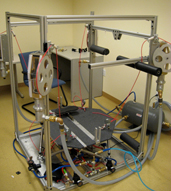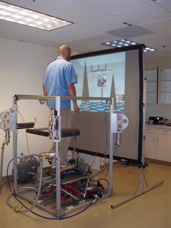An Integrated Musculoskeletal Countermeasure Battery for Long-Duration Lunar Missions

The Combined Countermeasures Device (CCD) is a novel exercise device that combines balance and coordination training with resistance exercises designed to target specific muscle groups at the hip and lower extremity. Exercises are performed on a Stewart platform, which can be suspended using the air-filled cylinders underneath. The wheels and red cables mounted at the corners of the CCD transmit forces from the Subject Loading Devices (SLDs), which operate using pressurized air. Click here for larger image.
Principal Investigator:
Thomas F. Lang, Ph.D.
Organization:
University of California, San Francisco
It is unknown how well the musculoskeletal system will hold up during long stays in the reduced gravity of the lunar surface. It’s likely that without countermeasures, there will be adaptive changes in muscle strength, bone mineral density, bone geometry and sensorimotor ability. Considering the construction and exploration tasks inherent in operating a lunar base, the risk of injury is elevated.
Dr. Thomas F. Lang and colleagues are testing a novel exercise device that combines balance and coordination training with resistance exercises designed to target specific muscle groups at the hip and lower extremity. They are currently carrying out a study in normal volunteers to assess the ability of the device to produce improvements in strength and endurance. The next goal will be to test the device in a bed-rest study. Using pre- and post-bed-rest comparisons of aerobic capacity, balance, muscle strength, biochemical and imaging-based measures of skeletal metabolism, density and strength, the team will determine whether the countermeasure preserves fall and injury-related indices of neuromuscular performance while maintaining skeletal integrity and cardiovascular function.
NASA Taskbook Entry
The degree to which the musculoskeletal system will maintain its integrity during prolonged sojourns in the reduced gravity of the lunar surface is presently unknown. It is, however, likely that without countermeasures there will be adaptive changes in muscle strength, bone mineral density, bone geometry and sensorimotor status. When the combined effects of these changes are considered in the context of the construction and exploration tasks that will be performed at the lunar base or at other lunar sites, the risk of injury secondary to a fall is likely to be elevated.
To address this fundamental problem, we constructed a compact platform that integrates a time-efficient integrated battery of countermeasures that can be conducted in the confines of the lunar habitat to minimize the risk of musculoskeletal injury. Ultimately, we expect that this battery of countermeasures will be validated using a 10 degree head-up bed-rest simulation of a lunar mission, although it could also be tested in the standard 6 degree head-down simulation.
Specific Objectives of Countermeasure Battery
1. To preserve muscle strength and cardiovascular fitness.
2. To minimize decrements in postural stability, dynamic balance, and the ability to make corrective actions prior to a fall.
3. To preserve functional performance on mission-relevant tasks.
4. To minimize bone loss in the proximal femur.
To accomplish these objectives, we have constructed a unique multi-functional countermeasure device which integrates cardiovascular, balance control and resistance training functions. The stepper system provides cardiovascular exercise. When the stepper is locked down, the device may be utilized for lower-body strengthening exercises such as squats, leg extensions and abductor/adductor exercises. To facilitate balance training, the stepper/resistive system is mounted on a Stuart Platform allowing 3D translations with a range of +/- 10 cm and pitch/yaw/roll of +/-10 degrees.
In the second and third years of the study, we have re-scoped the project to carry out a training study in which we have evaluated the ability of Combined Countermeasure Device (CCD) exercise to generate improvements in cardiovascular function and lower-body resistive strength.
Fifteen subjects underwent a 12-week training study which involved three weekly, one-hour sessions of cardiovascular and lower-body resistive training. The cardiovascular training initially involved stepper exercise (five subjects, 5 percent mean with a 12-week improvement in V0₂ max, non-significant change). However, based on poor results, we changed the aerobic protocol to bike exercise (10 subjects, 27 percent mean with a 12 week improvement in V0₂ max, p0.004), following a design simulation. This illustrated that a compact exercise bike could be folded into the footprint of the CCD.
The 10 subjects who exercised on the bike showed improvements ranging from 17-38 percent. Leg press strength increased in all 15 subjects over 12 weeks (mean change 68 percent, range 47-85 percent, p=0.0001). Isokinetic strength measures showed variable response, with hip abduction, adduction and ankle plantar flexion strength increasing by 22 percent, 31 percent and 13 percent respectively (all p<0.05), but leg extension, leg flexion and hip flexion strength showed non-significant increases. Weight lifted by all subjects in each exercise increased significantly (all exercises p=0.0001) over the course of the study. Thus, from our training study data, we were able to conclude that CCD exercise was well tolerated and could produce significant improvements in physical fitness which would achieve the goal of the training study.
Because one of the key goals of the project is to develop a novel exercise protocol in which squatting and hip ab/adduction exercise is employed to protect against hip bone loss, Dr. Peter Cavanagh's group has adapted the Lifemodeler computational tool to simulate the effect of the muscle contractions produced by CCD squatting and ab/adduction exercise on the hip. This calculation incorporates the contractions of 47 muscles in the leg, and fully models all of the CCD exercise.
To validate this model, Dr. Cavanagh and Dr. Hanson utilized the Orthoload Database which contains results from studies of volunteers who received hip prostheses instrumented with strain sensors, allowing for calculation of hip loading forces associated with different exercises, including abduction and squatting. Simulating the exercise protocols used in the Orthoload Study, the Lifemodeler calculations produced hip loads that were in quantitative agreement with the measured Orthoload results, validating the use of Lifemodeler to estimate load forces on the hip associated with CCD exercises. These calculations showed that in Earth’s gravity CCD abduction exercise produced peak forces of four body weights on the hip, compared to 2.5 body weights for squatting exercise.
We presented the results of our training study and Lifemodeler work to the Health and Hospitals Corporation Control Board. Based on the heavy load on the Bed-rest Facility placed by the ongoing aRED studies, it was decided not to place the CCD into the bed-rest study, but follow-up on our ab/adduction results were considered highly exciting and worthy of pursuit. Based on this evaluation, the final year of our project will include a detailed evaluation of the effects of ab/adduction exercise on hip bone strength and density as measured by quantitative computed tomography and finite element modeling. This study will compare standard aRED lower-body exercise, combined aRED and ab/adduction, and ab/adduction only, maintaining the same number of repetitions per group.
Outside of the space medicine community, there is a growing appreciation of the importance of an integrated musculoskeletal approach toward prevention of age-related skeletal fractures. Hip fractures, which represent the most serious manifestation of osteoporosis, rarely occur without falls, and the exercise strategies developed here could potentially be adapted to an older demographic, with the same compact exercise and balance countermeasures geared toward reduction of falls and bone loss in the growing population of elderly.
We believe that the compact characteristics of the combined countermeasure devise which are optimal for the spaceflight environment will also fulfill the needs for an in-house exercise device or for a nursing home. It is well known that impaired balance is associated with aging and with an increased risk of falling. Balance training exercise in the elderly has been shown to reduce risk of falls.
In particular, resistive exercise has been shown to increase muscle strength in the elderly, and increases in muscle strength and balance are associated with improvements in performance and mobility, which are important determinants of quality of life in the elderly. Finally, by focusing on resistive exercise in the abductor and adductor muscle groups, this device is expected both to improve lateral balance and reduce the rate of age-related bone loss by stressing those muscle groups that attach at the hip and thus providing significant mechanical loads on the proximal femur.







